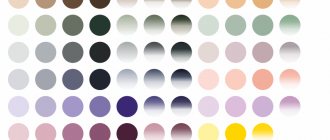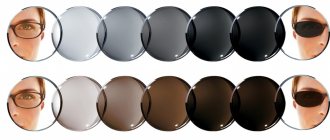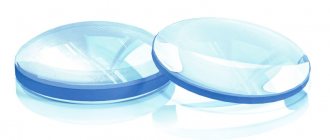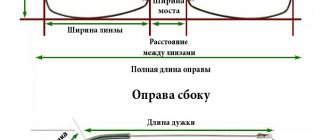Glasses are often an invariable attribute of a modern person who has to spend a lot of time at the computer, because not everyone has the opportunity and desire to wear contact lenses. However, not only people with poor eyesight wear glasses; it is also quite a stylish accessory, and sunglasses, waiting in the wings, lie on almost everyone’s shelf.
No matter what kind of glasses you have - for vision correction, perforated, sun protection, decorative without lenses, expensive branded ones or cheap ones bought on the market for a hundred rubles - they tend to break. Frames usually break, but broken lenses are not uncommon. How often do we sit down on the sofa and suddenly hear an unpleasant crunch? This crunch indicates that it is time to buy new glasses.
It's a pity! Maybe it's not too late to fix everything? If, for example, you figure out what glasses are made of and how to fix them yourself?
Glasses design
The main element of any glasses is lenses made of glass or plastic. The lenses are inserted into a frame, to which using hinges . The hinge has a fixed part, fixed in the frame, and a movable part, welded to the metal core of the earhook and fixed in its plastic part. Some models use a headband or elastic band instead of temples.
The bridge between the two lenses is called a “bridge,” or nose bridge, and the plastic or silicone pads that protect the bridge of the nose from the strong pressure of the frame are called nose pads, which, like the temples, are attached to the glasses using hinges. The presence of nose pads is more typical for heavy metal glasses, while plastic glasses are quite light and do not put such pressure on the nose.
Any structural element of glasses can break, but the “bridge” and the junction of the frame with the temples (and nose pads, if any) are especially prone to breakage.
Frame structure
An important detail in glasses is the structure of the frame, since the appearance of the accessory depends on it. Depending on the level of vision and type of face, you should select the appropriate style of glasses; only in this case can you create a complete, spectacular image.
How are headband frames constructed?
Rim frames are considered classic; they consist of a frame in the form of a rim for fixing lenses and a nosepiece between the two halves. In these models, the frame consists entirely of durable material - plastic, metal, and polymer materials are used to make rim frames, but recently combined products that combine metal with wood, or plastic with decorative stone trim are popular.
Full-rim frames are considered universal, since such glasses can be worn by both men and women, and it is in this style that children's eye accessories are most often made.
Vision-correcting models with different lenses for each eye are made in rim frames, since different weights of lenses can cause glasses to skew to one side, and the use of a dense frame in this case corrects the weight balance.
In rim frames you can often see the use of flex temples; this is a special system with an additional spring, thanks to which the same model of glasses is applicable for different head widths. Elastic temples do not squeeze the temples, but at the same time they are firmly fixed on the face.
Structure of semi-rimless frames
Unlike standard rimless frames, semi-rimless frames are constructed slightly differently. They also have standard temples and nose bridge, but the type of frame is slightly modified. Part of the frame (be it the top, bottom or side) is made in the form of a fishing line, while the remaining section is a durable rim.
Depending on the type of structure, such frames are classified into:
- men's - frames in which the fishing line is located at the bottom of the lens;
- female - if the hard rim is located at the bottom, and the lens is attached to it on top using a fishing line;
- universal - the half-rim in them is made in neutral colors, it can be translucent material, pastel or silver color of the frame. These glasses are designed for reading.
The use of semi-rimless frames is possible if modern polymer (plastic) lenses are used, because the fishing line will not be able to withstand heavy glass.
In terms of design, this type of frames is not very rich in choice; most often, rectangular or elongated oval lenses are designed in this style; the specific structure of the rim does not provide for the use of other forms.
How do rimless frames work?
One of the most spectacular and stylish options for designing glasses is the use of frames without a rim. These glasses do not have a rim around the lenses, and the temples and nose bridge are attached using bushings or screws directly to the lenses.
Features of rimless frames:
- minimal weight - the absence of a heavy frame significantly lightens the weight of the accessory, this quality will be especially appreciated by clients with large diopters (since the lenses alone weigh a lot in glasses that suit them);
- invisibility - by installing thin lenses in glasses and using translucent silicone temples, you can make them as invisible as possible to others;
- versatility - unlike other types of glasses, models with rimless frames go perfectly with any style of clothing, so they will suit everyone without exception.
The only disadvantage of this choice is the limitation on the choice of lenses - only polymer products are suitable here, but today with such lenses you can choose glasses for anyone.
What to look for when buying glasses?
Regardless of the type of frame used, all glasses consist of a rim (except for rimless models), a nose bridge and temples. The design style of the lens rim is more decorative than particularly functional, so you can choose the frame of your glasses at your own discretion, the main thing is that the rim does not rise above the eyebrows and does not touch the cheeks below. But you should take a closer look at the quality and type of other parts.
- The nose bridge is a special recess for the nose; it can be supplemented with nose pads or left free. The stops can be movable (fixed on hinges) or rigid; for children's glasses, special plastic stops with a molded bridge between them are used. Thanks to this addition, the glasses do not move when worn and do not compress the soft tissues of the nose.
- Temples - the back part of the frame for attaching glasses behind the ears. According to the type of structure, the temples are divided into classic (with a maximum opening of up to 100 degrees) and spring (flex), which can be extended up to 150 degrees when putting them on.
The main point is to choose the optimal length of the straight part of the temple so that the glasses do not fall on the tip of the nose (if it is too long) and do not squeeze the ears (if it is not long enough).
Considering these main points when choosing glasses, you can choose the best option for yourself. However, remember that you cannot choose vision glasses on your own; you need to buy corrective models taking into account the characteristics of each organism, which requires consultation with a qualified ophthalmologist.
How to fix a nose bridge yourself?
Temporary bridge repair using paper and glue
The good news is that even a child can handle this task! You just need to find superglue (Moment will do) and glossy paper, the color of which is not very different from the frame (however, you can play with the contrast).
The paper needs to be cut into thin strips and carefully wrapped around the nose piece to the desired thickness, not forgetting to coat it with glue. Before applying a new layer, you need to wait until the old one dries.
The glasses are ready! Now you can safely wait until you go to a repair specialist.
Repairing the “bridge” with a pin
Also quite an interesting way. You will need a small saucepan or bowl of boiling water and a pin.
First you need to melt the plastic, for which the ends of the “bridges” formed during the split are lowered as close as possible to boiling water. When the ends have softened , you need to insert a short pin into one of them (you can “pinch off” part of the pin with wire cutters), and then put the other end on it. The resulting gap should be smoothed out by hand before the plastic hardens. Glasses are like new!
Professional bridge repair
This method is essentially similar to the previous one, but requires more attention, accuracy and diligence. In addition, you will need various tools:
- thin drills with a diameter of 1 mm and 1.5 mm,
- cutter,
- steel wire with a diameter of 1.2 mm,
- nichrome wire with a diameter of 0.3 mm,
- sandpaper,
- acetone-based glue (this is best suited for working with spectacle plastic).
In the ends formed when the frame splits, it is necessary to drill two holes with a diameter of 1.5 mm and a depth of 5 mm, then drill through holes with a diameter of 1 mm above and below them . Use a cutter to create grooves between the top two holes as well as the bottom two holes. Pour glue into holes with a diameter of 1.5 mm and insert a steel wire 9 mm long. Grease the ends with glue and connect. Fasten the structure with nichrome wire passed through the upper and lower holes. Fill the holes and grooves with glue, and after drying, sand them with sandpaper.
Metal frame bezel
The glass is periodically wiped, and the load on the rim increases significantly. A break in the metal holding arc is eliminated by fixing the glass with an adhesive composition. The glue is applied not only to the broken area, but to the entire surface in contact with the lens. For repairs, Contact glue is often used; it guarantees the necessary strength. It is applied to the degreased surface of the supporting arc, the edge of the lens. After this, the connection is tightly fixed; it is better to wrap the repaired part with threads. Care is needed when working with plastic lenses; they are protected from glue with tape. Glass does not interact with most adhesive mixtures.
How to replace a lost screw?
Temporary hinge repair
You can make temporary repairs to the hinge, which will allow you to wait for a trip to a specialist, using a toothpick, wire, pin or nylon fishing line.
The frame and temple of the glasses are aligned relative to each other so that a hole is formed in the hinge into which a toothpick is inserted (or whatever comes to hand from the list presented). The excess part of the toothpick must be cut off, the wire must be twisted, and the nylon fishing line must be melted in the flame of a lighter or match.
Repair of a hinge with a flex mechanism
The flex mechanism is used to fix the temples of the glasses in a certain position - very convenient for those who have a non-standard head size! Unfortunately, such a wonderful device has a serious drawback: a screw that has fallen out of such a hinge is very difficult to put back in place.
The fact is that between the two parts of the hinge there is a movable bar, which, when the screw falls out, is pulled into the arch. To pull out the bar , you need to fix the bow (for example, using a vice) and, holding the frame and the bar pulled out with a needle or screwdriver with one hand, screw the screw into the hinge.
It may not work out the first time, but don't give up! A few tries and you're done.
Repair of flex glasses frames
It is more difficult to repair a spring hinge: when a screw is lost, the movable eye is partially retracted into the shackle, and the holes for the screw do not match. It is more convenient to return the flex to its place with a pin or tweezers. But to screw in the screw, it is necessary to fix the hinge assembly in a vice; the jaws are softened with leather or velor pads so that there are no dents left on the frame. The flex is pulled out by the ledge located in the bow. The process of screwing in a screw is complex; you must simultaneously:
- pull out the ear;
- support the frame;
- insert a screw into the formed channel.
How to adjust the temples yourself?
Sometimes it happens that after being carried for a long time in a bag or a short-term unsuccessful contact with something heavy, the glasses do not seem to be broken, but they are still not very comfortable to wear: they put pressure on the ears, the bridge of the nose, or, conversely, they constantly dangle and slide down. The reason may lie in incorrect adjustment of the temples and nose pads.
- To check whether the nose pads are adjusted correctly, you need to place the glasses on a flat surface and compare their positions relative to each other. To change the height of the glasses, the nose pads should be moved (if the glasses need to be raised) or moved apart (if the glasses need to be lowered).
- If your glasses are tight or loose, you need to soak the temples in hot water for a while or heat them with a hairdryer, and then straighten them slightly or, accordingly, bend them more. You must act carefully so as not to melt the arms or break them. This method is suitable for plastic frames. Wire frames are easily bent using small pliers.
With the help of simple devices, you can successfully repair glasses that are broken inappropriately or adjust the frames for maximum comfort.
Attaching the lens to the fishing line
Another common reason for glasses to break is a defect in the fishing line that supports the glass in the half-rim frame. It is attached in a bevel that runs along the entire height of the frame. Possible damage and methods for restoring glasses:
- the fishing line is not damaged, the glass falls out - the fishing line warms up a little (up to 35 degrees), the glass returns to its original place;
- the fishing line has fallen out of the bevel or broken off at the edge of the rim - the fragment supporting the glass requires complete replacement; for this, a regular 0.8 mm single-core fishing line is used.
A common cause of glasses breakage is a defect in the fishing line supporting the glass in the semi-rimless frame.
Stages of plastic frame repair work:
- the facets of the frame are freed from the old fishing line;
- a piece of a new one is cut to 10 cm;
- The fishing line is tried on, for this purpose the ends are slightly sharpened;
- if the new line does not fit into the channels, they are drilled out to the required diameter;
- After finishing the channels and determining the exact length of the fishing line, the ends are heated with a soldering iron and then tightly fixed in the bevels.
On a metal frame, the joint between the fishing line and the frame of the glasses is soldered. Solders:
- for stainless alloys – zinc chloride;
- for colored people – rosin.
The defect site is repaired with a soldering iron or laser.
Glasses frame temple
The temples are available in three types:
- plastic;
- combined;
- metal with silicone-coated earpiece.
More often, combined ones break; the weak point is the junction of the plastic temple and the metal bar of the temple. In these cases, two methods are applicable:
- laser welding, use a thin tungsten needle electrode;
- with a rivet connecting plates of non-ferrous metal, it is attached to the outside of the wide temple.
The cover is a metal strip with two holes at the edges. The corners are bent to the shape of the parts of the temple, they fix the temple in one position. Riveting is done with thin copper or brass wire. The overlay plate is usually matched to the texture of the metal of the glasses so that it fits harmoniously.
The weak point is the junction of the plastic temple and the metal temple bar
How to decipher a prescription for glasses
The ophthalmologist undergoes basic diagnostic tests:
- table for identifying visual acuity - it contains letters or pictures that a person determines only with each eye separately, the more lines he sees, the better his visual acuity;
- autorefractometry – refractive ability is determined for each eye separately, as well as additional criteria for the eyeballs, for example, the distance between the pupils;
- Ultrasound of the eyeballs to identify the location and normal structure of each intraocular element;
- ophthalmological perimeter - determination of normality or impairment of lateral vision;
- examination of the fundus – determination of the structure of intraocular elements using visual examination after drug dilation of the pupil.
These are the main diagnostic tests. If the doctor suspects any disease, he may prescribe additional research methods. For example, measuring intraocular pressure, angiography.
After all the tests have been completed, the patient receives a prescription for glasses. It displays indicators using abbreviations. Their decoding is in the table below.
| Abbreviation | Decoding |
| O.D. | Designation of the indicator for the right eye. The values are written on the left side of the form |
| OS | Designation for the left eye. Information for this organ of vision is prescribed a little lower after the right eye |
| OU | Values described for both eyes simultaneously. This is necessary when any adjustment is required for two organs of vision at once. |
| Sph | Optical power, that is, an indicator that determines the necessary adjustment of the patient’s visual acuity. The number is expressed in diopters and can be positive for myopia, or negative for hypermetropia. This is the most important part of the glasses prescription, which is used to select lenses. |
| Cyl | This designation is used for the optical gain required for a cylindrical lens. It is used to select lenses that are necessary to correct astigmatism. |
| Prism | The physician points to this designation if the patient needs to be fitted with a prism lens. This type of lens is suitable for people suffering from myopia |
| Ax | This measurement is carried out in degrees in the range from 0 to 180. The indicator is necessary for the cylindrical tilt of the lens |
| Add | An indicator indicating the difference between the closest and farthest point at which a person can see well. Its measurement is necessary to select bifocal or progressive glasses when a person has both myopia and hypermetropia. That is, he sees poorly near and far. This condition develops after the age of 40 due to presbyopia (age-related changes in the organs of vision) |
| Dd | This is an indicator indicating the distance between the two pupils when the gaze is located strictly in the center. The value is necessary to correctly select the center of the lens for glasses |
After receiving the glasses prescription form, you must take it to the optician. There, a specialist will select a suitable frame, and the lenses will be made according to the data received.










